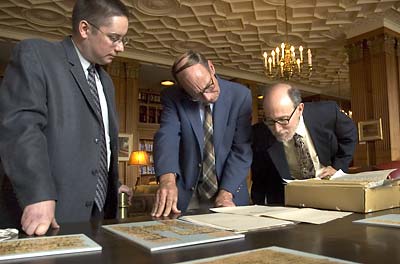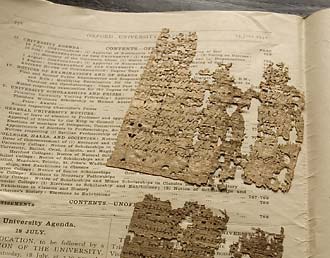UC Berkeley Press Release
 |
Todd Hickey, curator of the Center for Tebtunis Papyri, Anthony Bliss, curator of rare books and manuscripts at the Bancroft Library, and Donald M. Mastronarde, director of the Tebtunis center, examine papyri recently returned from Oxford. (Photos by Steve McConnell/UC Berkeley) |
Tebtunis papyri returned to UC Berkeley's Bancroft Library decades after their discovery
BERKELEY – Just a few weeks ago, three tins of ancient papyri belonging to the University of California, Berkeley, finally arrived home, shipped across the Atlantic more than a century after they were collected in Egypt.
British archaeologists Bernard Grenfell and Arthur Hunt excavated the temple, town and cemetery of Tebtunis, Egypt, in an expedition for UC Berkeley in the winter of 1899-1900 at the behest of university benefactress Phoebe Apperson Hearst. After uncovering a treasure trove of papyri and artifacts, they brought them to their home base at Oxford for study and publication of selected pieces.
 Fragments of papyrus rest in pages from back issues of the Oxford University Gazette (in this instance, the 15 July 1931 edition) in which they were shipped back from England. |
After the first two volumes were published, further publication was slowed by the illness and death of the two scholars, so the papyri remained at Oxford for longer than expected, said Todd Hickey, a papyrologist and curator of the Center for Tebtunis Papyri at UC Berkeley's Bancroft Library.
Although much of the material was eventually sent to the campus from the late 1930s through the '50s, additional containers remained overlooked, Hickey said.
But a couple of years ago, Hickey noted that an inventory of the numbering applied by Grenfell and Hunt to many pieces in the center's more than 30,000-piece collection showed many gaps in the sequence. The newly hired curator also noted that a research paper published by a University of Toronto scholar cited pieces of papyri that he studied at Oxford; they contained excavation numbers that identified them as part of UC Berkeley's Tebtunis collection.
"So, we had a pretty good idea there was material at Oxford that belonged to us," Hickey said.
Next, Donald Mastronarde, a UC Berkeley professor of classics and director of the Tebtunis Center, wrote to the chief of Oxford's Oxyrhynchus Center, which houses an extensive papyri collection assembled from a community north of Tebtunis, through the Egyptian Exploration Society.
Oxford University acknowledged possession of some pieces of the Tebtunis papyri collection, said Hickey, and efforts began in earnest to bring them home.
Some of the papers went on display today (Tuesday, Oct. 18) at UC Berkeley in a ceremony at the Morrison Library within Doe Library to celebrate the largest papyri collection in the United States.
Among the new materials are fragments of Euripides' "Phoenician Women," Homer's "Odyssey," an ancient medical handbook, and papers from an influential prophetess of the local crocodile god, as well as a family priest's writings that trace that a family's history over eight generations.
"There remains unknown and potentially blockbuster items in these boxes of mummy cartonnage," said Hickey.
Whatever they find, he said, UC Berkeley students and scholars will benefit by having still more papyri to review and study, he said.
In ceremonies today, Mastronarde noted that Hearst had hired the German scholar George Reisner as her agent to help with the Egyptian and Greco-Roman civilization materials from Tebtunis, but he ended his employment with her in 1905. He went to work for the Boston Museum of Fine Arts, where some of the Tebtunis documentary materials and four Middle Kingdom papyrus rolls remain to this day.
"We hope that the good example set by Oxford in the delivery of Mrs. Hearst's Tebtunis papyri may have some effect in persuading others to show a similar sense of cooperation," said Mastronarde.
Roger Bagnall, the 92nd Sather Professor of Classical Literature for fall 2005 at UC Berkeley and a professor of classics and history at Columbia University, said the recently transferred pieces of papyri appear relatively complete and in even better condition that some of the rest of the collection.
A leader in the field of papyrology, Bagnall said the items seem to push the date back even earlier for some of the materials found in Tebtunis, a village inhabited over 1,700 years ago.
The materials also will "connect some of the dots" between the Tebtunis Center material and that obtained from the Egyptian village by clandestine means and housed in other institutions scattered around the world, Bagnall said.
In addition, he said, studying the new documents should help shed new light on the archaeological processes used by Grenfell and Hunt in excavating what he called "one of the great finds in the field of papyrology."
The collection is significant for the insights it offers into everyday social relations and economic life in the 2nd century B.C., said Bagnall, and reflects the differences and similarities between the past and present.
Some of the findings made from the Tebtunis collection will be explored in an international conference, "Papyrology: New Directions in a New Generation," to be held at UC Berkeley Nov. 11-12.
More information about the Center for Tebtunis Papyri is available online at: tebtunis.berkeley.edu.

